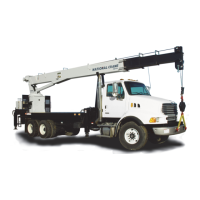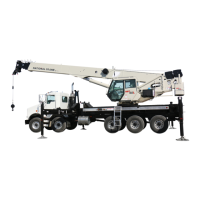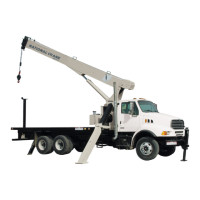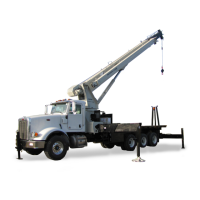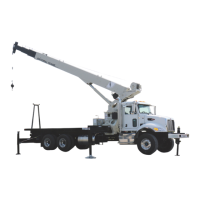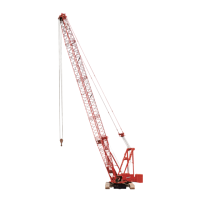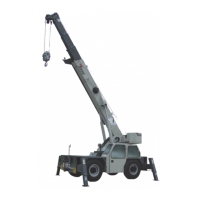NATIONAL CRANE Published 9-26-2018 Control # 646-02 2-31
NTC55 OPERATOR MANUAL SAFETY PRECAUTIONS
Ensure sheaves carrying ropes that can be momentarily
unloaded are equipped with close fitting guards or other
devices to guide the rope back into the groove when the load
is reapplied. Ensure sheaves in the lower load block are
equipped with close fitting guards that will prevent the ropes
from becoming fouled when the block is lying on the ground
with loose ropes.
To attain maximum rope life and minimize hook block
rotation, it is recommended that even numbers of parts-of-
line be used in multiple-part reeving whenever possible.
The use of nylon (polyamide) sheaves, as compared with
metallic sheaves, may change the replacement criteria of
rotation-resistant wire rope.
NOTE: The use of cast nylon (polyamide) sheaves will
substantially increase the service life of rope.
However, conventional rope retirement criteria
based only upon visible wire breaks may prove
inadequate in predicting rope failure. The user of
cast nylon sheaves is therefore cautioned that a
retirement criteria should be established based
upon the user’s experience and the demands of his
application.
Batteries
Battery electrolyte must not be allowed to contact the skin or
eyes. If this occurs, flush the contacted area with water and
consult a doctor immediately.
When checking and maintaining batteries, exercise the
following procedures and precautions:
• Wear safety glasses when servicing batteries.
• If equipped, disconnect battery with the battery
disconnect switch before disconnecting the ground
battery cable.
• Do not break a live circuit at the battery terminal.
Disconnect the ground battery cable first when removing
a battery and connect it last when installing a battery.
• Do not short across the battery posts to check charge.
Short circuit, spark, or flame could cause battery
explosion.
• Maintain battery electrolyte at the proper level. Check
the electrolyte with a flashlight.
• If applicable to your crane, check battery test indicator
on maintenance-free batteries.
• Check battery condition only with proper test equipment.
Batteries shall not be charged except in an open, well-
ventilated area that is free of flame, smoking, sparks,
and fire.
Engine
Fuel the crane only with the engine turned off. Do not smoke
while fueling the crane. Do not store flammable materials on
the crane.
Be familiar with the location and use of the nearest fire
extinguisher.
Be careful when checking the engine coolant level. The fluid
may be hot and under pressure. Shut down the engine and
allow the radiator time to cool before removing the radiator
cap.
Shut down the engine and disconnect the battery before
performing maintenance. If unable to do so for the task
required, keep hands clear of the engine fan and other
moving parts while performing maintenance.
Be careful of hot surfaces and hot fluids when performing
maintenance on or around the engine.
Do not use ether to start the engine on cranes equipped with
intake manifold grid heaters.
TRANSPORTING THE CRANE
Before transporting the crane, check the suitability of the
proposed route with regard to the crane height, width, length,
and weight.
Check load limits of bridges on the travel route and ensure
they are greater than the combined weight of the crane and
transporting vehicle.
When loading or unloading the crane on a trailer or railroad
car, use a ramp capable of supporting the weight of the
crane.
Ensure the crane is adequately secured to the transporting
vehicle.
Do not use the dead end lug on the boom nose for tying
down the boom during transport. Damage to the lug and
boom can result from usage as a tie down point.
Before transporting the crane on a road or highway, first
check state and local restrictions and regulations.
Either the hook block may be reeved over the main boom
nose or the headache ball may be reeved over the main
boom nose or auxiliary boom nose; the other must be
removed. If the hook block or headache ball remains reeved
on the boom, it must be secured at the tie down on the carrier
to prevent swinging.
When using hookblock tie downs, excessive loading can be
applied by pulling the cable too tight, particularly when
reeved with multiple part lines. When the cable is hooked
into the hookblock tie down, the cable should be merely
“snugged-up” with adequate slack provided at the center line
of sheave to anchor point and avoid contact with surrounding
components. Do not draw cable taut. Care must be

